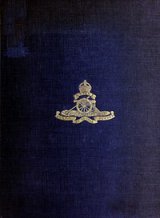The History of the 33rd Divisional Artillery, in the War, 1914-1918 Page #4
"Yet the record of their actions is their best memorial." Field-Marshal
Earl Haig wrote the above words in his foreword to the Royal Artillery
War Commemoration Book. When it is recalled that during the Great War
some three-quarters of a million of men fought guns of all calibres in
every quarter of the globe, it may be realised that to write the history
of the part taken by the Royal Regiment of Artillery as a whole must
prove an impossible task.
All the more important therefore that each unit should take steps to
place on record its own doings.
The 33rd Divisional Artillery fought in many important battles and
engagements, and always fought with distinction and with the devotion
worthy of the tradition of the Royal Regiment. This record bears witness
of the high stage of efficiency attained by the Brigades and Batteries
of the New Army, and we may say with our great Commander-in-Chief "The
record of their actions is their best memorial."
- Year:
- 2016
- 1,112 Views
Bulford wrought a tremendous change in the Divisional Artillery, which was now under the command of its own C.R.A. Brigadier-General Stuart. Here there was room to move; there was different country to work over each day; there were schemes on a far more elaborate scale than had been possible at Dulwich. The official syllabus of training was steadily worked through, and gradually this training became more interesting, more attractive as dull routine was left behind and sham warfare put into practice. The batteries were fully equipped with guns, even the 167th Brigade, which was a 4·5 in. howitzer brigade and had been greatly handicapped by a total inability to get howitzers from anywhere, being finally fitted out, and at last, in the early part of November, the batteries were given a chance of putting into effect on the practice ranges all that they had been learning by tedious and hard work during the period of training. One hundred rounds per battery were fired, and in most cases the results were very satisfactory when the shortness of training and the utter lack of previous experience were taken into account. The batteries were complimented by General Drake on the good service and drill at the guns, and returned to camp more anxious than ever to get to France, more keen than ever to fire a shot in anger now that they had fired one in cold blood. Rumour, already in high activity throughout the camp, became trebly busy since there appeared no further obstacle to keep the Division in England, and rumour was strengthened by the granting to the men of that last leave—overseas leave—which was given prior to departure for France. It was in December that it came, December 6th to be quite accurate. Just a bald official order to proceed overseas, accompanied by a mass of typewritten time-tables, march tables and all the paraphernalia inevitable in a move of such dimensions. The great moment had arrived at last, the moment for which all had waited so long, so eagerly and with such excitement, and any pangs which might naturally have been felt at a parting such as this, any dark forebodings which a look into the future might have called up, were mercifully and naturally effaced by the bustle, the excitement, the "fever," if you like, of the whole affair. On December 10th, at 4 P.M., the entraining of the batteries began at Amesbury and continued at intervals throughout the night. Fifty-one trains in all it took to move the batteries and their attendant ammunition columns, the last train leaving Amesbury at 4.5 P.M. on December 12th. Two days of bustle and excitement, two days of movement and stir around Amesbury, two days during which the station was crowded and packed with horses, guns and men sweating, heaving, swearing—and then silence. As though by a magic hand the 33rd Divisional Artillery was picked up and disappeared, and for a space it was hidden from the sight of man.
Translation
Translate and read this book in other languages:
Select another language:
- - Select -
- 简体中文 (Chinese - Simplified)
- 繁體中文 (Chinese - Traditional)
- Español (Spanish)
- Esperanto (Esperanto)
- 日本語 (Japanese)
- Português (Portuguese)
- Deutsch (German)
- العربية (Arabic)
- Français (French)
- Русский (Russian)
- ಕನ್ನಡ (Kannada)
- 한국어 (Korean)
- עברית (Hebrew)
- Gaeilge (Irish)
- Українська (Ukrainian)
- اردو (Urdu)
- Magyar (Hungarian)
- मानक हिन्दी (Hindi)
- Indonesia (Indonesian)
- Italiano (Italian)
- தமிழ் (Tamil)
- Türkçe (Turkish)
- తెలుగు (Telugu)
- ภาษาไทย (Thai)
- Tiếng Việt (Vietnamese)
- Čeština (Czech)
- Polski (Polish)
- Bahasa Indonesia (Indonesian)
- Românește (Romanian)
- Nederlands (Dutch)
- Ελληνικά (Greek)
- Latinum (Latin)
- Svenska (Swedish)
- Dansk (Danish)
- Suomi (Finnish)
- فارسی (Persian)
- ייִדיש (Yiddish)
- հայերեն (Armenian)
- Norsk (Norwegian)
- English (English)
Citation
Use the citation below to add this book to your bibliography:
Style:MLAChicagoAPA
"The History of the 33rd Divisional Artillery, in the War, 1914-1918 Books." Literature.com. STANDS4 LLC, 2024. Web. 15 May 2024. <https://www.literature.com/book/the_history_of_the_33rd_divisional_artillery%2C_in_the_war%2C_1914-1918_4>.




Discuss this The History of the 33rd Divisional Artillery, in the War, 1914-1918 book with the community:
Report Comment
We're doing our best to make sure our content is useful, accurate and safe.
If by any chance you spot an inappropriate comment while navigating through our website please use this form to let us know, and we'll take care of it shortly.
Attachment
You need to be logged in to favorite.
Log In